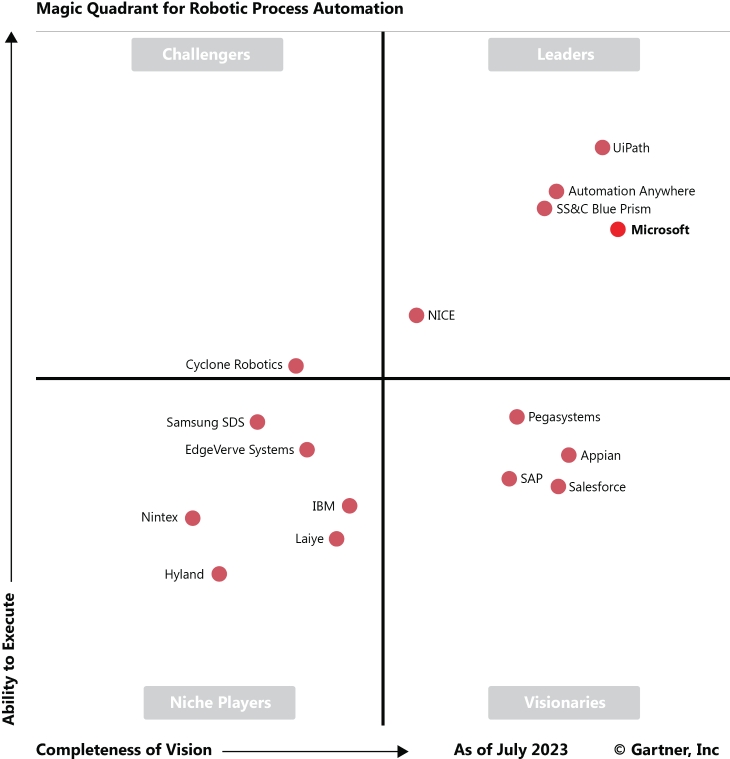Robotic Process Automation (RPA) continues to drive enterprise efficiency, automating tasks across diverse sectors. The benefits are strikingly similar regardless of the use case: bolstered security, improved customer experiences, and increased agility.
Done right, RPA transformation unlocks time, money and human capital in the organization, freeing resources to focus on valued-added tasks, and helps IT leaders deliver on business priorities.
As the RPA landscape matures, four tools dominate: SS&C BluePrism, AutomateAnywhere, UI Path, and Microsoft Power Automate. Particularly noteworthy is Microsoft's Power Automate, which, according to Gartner's 2023 Magic Quadrant, not only competes with specialist vendors but is recognized as the most visionary tool.
The Gartner Magic Quadrant reveals that Microsoft has not only risen to match its competitors but has edged forward as the most visionary with Power Automate. This leading position, albeit modest, is a sign of Microsoft's aggressive investment and the swift enhancement of their RPA solutions, outstripping the rate of change seen by others.
What is a Robotic Process Automation (RPA) Tool?
An RPA tool employs 'bots' to replicate rule-based human actions, such as system navigation and data extraction, without needing integrations. This frees skilled workers to focus on innovation. RPA tools enhance productivity through intelligent automation and offer seamless, low-code process automation.
The challenge for many complex organizations is that RPA is typically implemented in silos, resulting in 'bots' that don't communicate with each other without significant human intervention. Layer on the cumulative cost of individual licenses and it’s enough to give pause for thought. Advanced RPA providers integrate their tools with AI, leading to "hyperautomation." However, traditional RPA bots have limitations, such as an inability to interpret complex data or adapt to minor changes in user interfaces, which can disrupt workflows.
Gartner Magic Quadrant Analysis for RPA Tools
Gartner's Magic Quadrant evaluates RPA vendors on their ability to execute and completeness of vision, assessing factors like product or service viability and customer experience.
Discover the Top 4 Leading RPA Tools for 2024
Blue Prism
Blue Prism stands as one of the original RPA tools, carving out a niche in automating complex, enterprise-scale business processes. Predominantly catering to large-scale corporate applications, it exclusively supports unattended automation. Blue Prism's broad suite includes intelligent automation features like data collection, analysis, visual analytics, machine learning, and collaborative automation. Its robust capabilities are a fit for enterprises prioritizing stability and security, especially for back-office operations.
However, critiques have emerged about Blue Prism's responsiveness to customer feedback and the high costs associated with customization and deployment. This resistance to agility may hinder its position as a driver of innovation.
UI Path
UI Path differentiates itself with a user-centric design that appeals to a broad user base, from tech-savvy to non-technical staff. It excels in its scalability, catering well to the needs of small and mid-sized businesses with its low initial costs and quick onboarding process.
UI Path's integration capabilities cover both attended and unattended applications, providing flexibility and immediate operational benefits. Despite its advantages, UI Path’s specialized nature means escalating licensing costs as automation scales up, presenting a potential issue for organizations expanding their RPA footprint.
Automation Anywhere
Automation Anywhere is renowned for its blend of RPA and AI, creating a cognitive automation environment appropriate for a variety of sectors. The platform stands out for its user-friendly interface, enabling beginners and intermediate users to automate complex processes with ease.
Automation Anywhere boasts a supportive community forum, rich in resources like metabots for advanced tasks. Its recognition on platforms like G2 for a robust bot security framework and high compliance standards makes it a trusted option for organizations requiring stringent security measures, particularly in rapid scale-up scenarios.
Read G2 Report for Automation Anywhere
Microsoft Power Automate
Microsoft Power Automate was recognized by Gartner in 2023 as a visionary leader, thanks to its unified approach to automation within Microsoft's integrated suite of technologies. It is particularly adept at managing trigger-based workflows, streamlining simple to moderately complex tasks.
Power Automate's extensive array of connectors allows for rapid integration across various applications within the Microsoft ecosystem, positioning it as an ideal solution for Microsoft-centric enterprises. Notably, it provides substantial licensing cost advantages through enterprise-level bundling, enhancing its value proposition for Microsoft's established clients.
Read G2 Report for Power Automate
Selecting the Right RPA Tool for Your Enterprise:
The choice of RPA tool should be based on factors like integration capabilities and the scale of digital transformation required. There's no one-size-fits-all; the decision hinges on the organization's size, automation complexity, and strategic goals.
For Microsoft Enterprise clients, Power Automate presents a strategic opportunity for integrated and efficient automation, with the potential to free up a huge level of resources locked in the organization. A recent article in Forbes cites a 27.4% improvement in business process efficiency and a 20.7% reduction in errors for organizations adopting Power Automate vs. other RPA solutions.
Sonata Software have a dedicated RPArena, with specialists certified in all four of the leading RPA tools, as well as Bluprint integration technology. We offer a free 2-hour envisioning workshop for enterprises looking to modernize their RPA strategy.
Download Sonata’s NEW RPA Transformation Guide or contact us to explore how we can help you unlock the full potential of RPA modernization for your enterprise.
FAQs:
What are RPA tools and how do they benefit enterprises?
RPA tools automate repetitive tasks, freeing up human resources for higher-value work, thus benefiting enterprises by boosting efficiency and innovation.
How does the Gartner Magic Quadrant influence RPA tool selection?
The Gartner Magic Quadrant helps businesses assess the strengths and weaknesses of RPA vendors, guiding them to make informed decisions based on their specific needs.
What factors should businesses consider when choosing an RPA tool?
Businesses should consider the tool's integration capabilities, scalability, user-friendliness, and alignment with their strategic goals.




